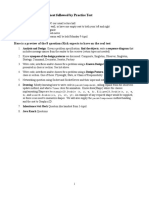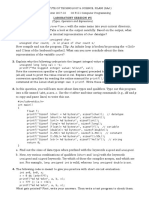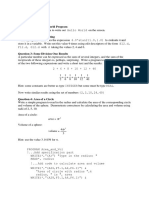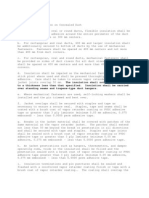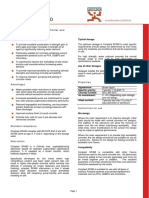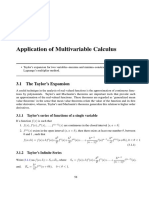CS 103 Lab 8 - Stay Classy CS103: 4.1 (10 PTS.) Finishing The Implementation of War
CS 103 Lab 8 - Stay Classy CS103: 4.1 (10 PTS.) Finishing The Implementation of War
Uploaded by
Rahul Ranjan PradhanCopyright:
Available Formats
CS 103 Lab 8 - Stay Classy CS103: 4.1 (10 PTS.) Finishing The Implementation of War
CS 103 Lab 8 - Stay Classy CS103: 4.1 (10 PTS.) Finishing The Implementation of War
Uploaded by
Rahul Ranjan PradhanOriginal Description:
Original Title
Copyright
Available Formats
Share this document
Did you find this document useful?
Is this content inappropriate?
Copyright:
Available Formats
CS 103 Lab 8 - Stay Classy CS103: 4.1 (10 PTS.) Finishing The Implementation of War
CS 103 Lab 8 - Stay Classy CS103: 4.1 (10 PTS.) Finishing The Implementation of War
Uploaded by
Rahul Ranjan PradhanCopyright:
Available Formats
CS 103 Lab 8 - Stay Classy CS103
1 Introduction
In this lab you will use several C++ classes to play the game of War. This will be an
interesting experiment, as you will be able to compare your PA1 to this labs
implementation.
2 What you will learn
After completing this lab you should be able:
Complete class implementations (i.e. member functions)
Understand how to declare instances of classes and call their member
functions
See the difference between your implementation of PA1 without classes,
and this implementation with classes
3 Background Information and Notes
Review your lecture slides on C++ classes.
Classes: To model the game of war we have defined three classes: Card, Deck, and
WarPlayer.
The Card class models a single card with a suit and a value. To make
comparison easy well model the value of a 2 card = 0, the value of a 3
card = 1, , the value of a K = 11 and the value of an Ace = 12.
You will need to complete the toString() function of this class in card.cpp.
Otherwise all the code is complete.
The Deck class models the collection of 52 cards and provides operations to
shuffle, cut, get the top card, and print the cards that remain in the deck.
This class is complete and doesnt need to be modified by you.
The WarPlayer class models a single player of the War game. It contains an
array of Cards (up to 52) which represent the cards the player currently
holds in their pile and provides methods for adding a card to the bottom and
removing and returning a card from the top of their pile.
You will be asked to add a member function or two to this class, but you
do not need to modify the member functions already provided.
4 Procedure
4.1 [10 pts.] Finishing the Implementation of War
Download the code files.
Last Revised: 3/7/2014
CS 103 Lab 10 - Stay Classy CS103
$ wget http://ee.usc.edu/~redekopp/cs103/war.tar
$ tar xvf war.tar
This will extract the following files:
card.h and card.cpp
Class definition and implementation for a Card class
deck.h and deck.cpp
Class definition and implementation for a Deck or
cards
warplayer.h and
Class definition and implementation for a Player in
warplayer.cpp
the game of War
war.cpp
The main application where you will instantiate
Decks and Players and play the game.
Makefile
Makefile to compile the program and create ./war
Now make the following alterations:
1. Complete Card::toString() function by using a stringstream to produce the
string that the function returns. The format of the string should be the card
value (i.e. 2,3,10,J,K,Q,A) followed by a - then the suit {C=Clubs, D =
Diamonds, H = Hearts, S = Spades}. As an example, the 10 of Clubs should
be represented with a string 10-C, the Ace of hearts should be A-H. Be
sure to #include both <sstream> and <iostream>.
2. Add two member functions to the WarPlayer class.
a. One function should check if the player DOES HAVE any cards
remaining by examining the _size variable and return true (a
Boolean) if _size is not equal to 0, false otherwise. Use this function
in war.cpp to check if one of the players is out of cards.
b. The second function should just return the value of _size which is a
private data member. You can use this for debug purposes if desired.
c. Add prototypes for the functions in the warplayer.h class definition
and then add the implementations in warplayer.cpp
3. Modify war.cpp to model the gameplay
a. We have given some initial code to get you going. Notice the loop
that will play the game numSims times, where numSims is the value
of the 1st command line argument you provide.
b. We already create and shuffle the deck.
c. Youll need to write a loop to model a single game that continues
until one player does NOT have cards left. Follow the requirements
from the previous section.
d. Be sure to update the statistics: numBattles, numWars, p1Wins,
p2Wins.
e. Our code will print out the statistics at the end.
4. Compile your program and fix any compile errors
$ make
Last Revised: 3/7/2014
CS 103 Lab 10 - Stay Classy CS103
5. Test your program with just 1 simulation and the debug flag turned on to
see if things make sense (add some debug print statements to see variables
values or other info that would help you verify the correct operation).
$ ./war 1 1
6. Then test your program for a large number of simulations with the debug
flag turned off. Feel free to post your statistics (always list the number of
simulations you are using) on Piazza to verify your code. (Remember though
this is a random simulation so results may vary but should converge for a
large number of simulations).
$ ./war 10000 0
7. Show your TA/CP the functions you wrote and added. Demonstrate your
program running for just 1 simulation (i.e. 1 game) with the debug flag
turned on so we can see the deck and carts printed out (to make sure
Card::toString() works. Then demonstrate your program running for
10,000 simulations (with the debug flag turned off)
Last Revised: 3/7/2014
You might also like
- Final - DNN - Hands - On - Jupyter NotebookDocument8 pagesFinal - DNN - Hands - On - Jupyter Notebooktango charlie25% (8)
- Department of Computer Science National Tsing Hua University EECS403000 Computer ArchitectureDocument5 pagesDepartment of Computer Science National Tsing Hua University EECS403000 Computer ArchitectureTetricx The firstNo ratings yet
- Analysis of A Short Organum To The TheatreDocument5 pagesAnalysis of A Short Organum To The TheatreSanya AgrawalNo ratings yet
- CPE 325: Embedded Systems Laboratory Laboratory Assignment #4Document2 pagesCPE 325: Embedded Systems Laboratory Laboratory Assignment #4Sheeraz AliNo ratings yet
- Computer ProgrammingDocument63 pagesComputer ProgrammingParul GargNo ratings yet
- Semester 1 Examinations, 2020-2021: Exam Code(s) Exam(s)Document5 pagesSemester 1 Examinations, 2020-2021: Exam Code(s) Exam(s)Mikel SylvesterNo ratings yet
- Word Association Test Examples PDF For SSB (500+ W+Document20 pagesWord Association Test Examples PDF For SSB (500+ W+Stylish Sarathi100% (2)
- Battery 3 Library Manual EnglishDocument91 pagesBattery 3 Library Manual Englishnatan_ex100% (1)
- New Text DocumentDocument10 pagesNew Text DocumentdustboyNo ratings yet
- June 2014Document8 pagesJune 2014fast furiosNo ratings yet
- Question #1 - ClassesDocument9 pagesQuestion #1 - ClassesdavidNo ratings yet
- Assignment 1: Learning OutcomesDocument7 pagesAssignment 1: Learning OutcomesLing MaNo ratings yet
- (Handout) Lab 1 - C Programming and MakefilesDocument13 pages(Handout) Lab 1 - C Programming and Makefilesmir.inzamam200No ratings yet
- Deck of CardsDocument5 pagesDeck of CardsStanimir PetkovNo ratings yet
- CMPT 120, Fall 2008, SFU Burnaby Instructor: Diana CukiermanDocument3 pagesCMPT 120, Fall 2008, SFU Burnaby Instructor: Diana CukiermantanubajpaNo ratings yet
- Lab 2Document8 pagesLab 2SAURABH DEGDAWALANo ratings yet
- Cellular Automata: Examples Using C++, QT, Python, Wxpython and NumpyDocument13 pagesCellular Automata: Examples Using C++, QT, Python, Wxpython and NumpyDharanaNowNo ratings yet
- Cryptography - Exercises: 1 Historic CiphersDocument7 pagesCryptography - Exercises: 1 Historic CiphersBeni RodriguezNo ratings yet
- 15 122 hw2Document10 pages15 122 hw2Ryan SitNo ratings yet
- Topic 2. Visual Data Analysis in Python: Mlcourse - Ai (Https://mlcourse - Ai)Document15 pagesTopic 2. Visual Data Analysis in Python: Mlcourse - Ai (Https://mlcourse - Ai)rastamanrmNo ratings yet
- I C 152 Lab Assignment 8Document10 pagesI C 152 Lab Assignment 8Hansraj SwamiNo ratings yet
- Workshop Four (W04) : Melbourne School of Engineering Engineering Systems Design 2Document10 pagesWorkshop Four (W04) : Melbourne School of Engineering Engineering Systems Design 2Kunal RamnatsingNo ratings yet
- Lab-Python 2Document4 pagesLab-Python 2a.isaku23No ratings yet
- Chapter 6 Solution PDFDocument7 pagesChapter 6 Solution PDFgauravroongtaNo ratings yet
- CSC 335 Test 2 Review Sheet Followed by Practice TestDocument10 pagesCSC 335 Test 2 Review Sheet Followed by Practice Testtrass infotekNo ratings yet
- Lab 7: FunctionsDocument21 pagesLab 7: FunctionsTophe EscarezNo ratings yet
- ECE408 2012 Practice Exam1Document10 pagesECE408 2012 Practice Exam1shahdabdelrhman8xNo ratings yet
- Lab -4 IPPDocument5 pagesLab -4 IPPAsmit patraNo ratings yet
- Elements of Computing Systems Appendix BDocument7 pagesElements of Computing Systems Appendix BSaad Imran δδNo ratings yet
- C Programming ExercisesDocument6 pagesC Programming Exercisesparth149No ratings yet
- C Programming Course - Worksheet FiveDocument5 pagesC Programming Course - Worksheet FiveavishanaNo ratings yet
- ArchlabDocument13 pagesArchlabznzhang03No ratings yet
- Dsp ReviwerDocument38 pagesDsp ReviwerBernardo ColesNo ratings yet
- Guia de Referência Da Linguagem de Programação Logic Basic 1.0.45Document81 pagesGuia de Referência Da Linguagem de Programação Logic Basic 1.0.45josé_alencar_57No ratings yet
- workshop7-2Document10 pagesworkshop7-2sarakhan20044No ratings yet
- Assignment 1: The World DataDocument11 pagesAssignment 1: The World DataRavinder SinghNo ratings yet
- Python PracticeQuestion 2014Document10 pagesPython PracticeQuestion 2014Sn LauNo ratings yet
- 10 BASIC program memory-saving tipsDocument4 pages10 BASIC program memory-saving tipsNovák PéterNo ratings yet
- Lab 05Document2 pagesLab 05vinayakagarwalNo ratings yet
- GPU Programming EE 4702-1 Final Examination: Exam TotalDocument10 pagesGPU Programming EE 4702-1 Final Examination: Exam TotalmoienNo ratings yet
- Mid ADocument9 pagesMid AKrishnaNo ratings yet
- St. Xavier's College: Python Language LabDocument13 pagesSt. Xavier's College: Python Language LabARPAN LAHANo ratings yet
- C Programming Exam: Game of Life 25-04-2017, 8:45-10.30Document22 pagesC Programming Exam: Game of Life 25-04-2017, 8:45-10.30Filipe FelisbertoNo ratings yet
- Task - PreprocessingDocument7 pagesTask - PreprocessingDurga Devi PNo ratings yet
- Fibercablelength UnderstandingDocument5 pagesFibercablelength Understandingayomide.adekoyaNo ratings yet
- Programming With AllegroDocument9 pagesProgramming With Allegrodarc_210No ratings yet
- T-Axi Suite of Turbomachinery Axisymmetric Design Codes: Inputs: - (Optional) OutputsDocument4 pagesT-Axi Suite of Turbomachinery Axisymmetric Design Codes: Inputs: - (Optional) OutputsShashank MishraNo ratings yet
- What Is The Difference Between Function and Method? Explain The Working of The Init Method With Suitable CodeDocument7 pagesWhat Is The Difference Between Function and Method? Explain The Working of The Init Method With Suitable CodeLikhith MNo ratings yet
- HW ProblemDocument6 pagesHW ProblemChaturaHomesNo ratings yet
- Procedure To Create The Memory GameDocument17 pagesProcedure To Create The Memory GameInderpartap CheemaNo ratings yet
- Beginnings of A Game: Lab Exercise FourDocument2 pagesBeginnings of A Game: Lab Exercise FourAnonymous 20wFhEPNo ratings yet
- 00047_writing_LimitationsDocument9 pages00047_writing_Limitationsabhishek.embaa22003No ratings yet
- Pps Solved 2019 NovemberDocument16 pagesPps Solved 2019 NovemberH CUBENo ratings yet
- Fortran 95 Practical ExercisesDocument10 pagesFortran 95 Practical ExercisesErich Manrique CastilloNo ratings yet
- ArchlabDocument6 pagesArchlabSameerNadeemNo ratings yet
- Deptt of Computer Science Engineering & IT, Juit: 10B28CI481: Computer Organization LabDocument45 pagesDeptt of Computer Science Engineering & IT, Juit: 10B28CI481: Computer Organization LabjagpreetsidhuNo ratings yet
- Assignment 3 DS5620Document11 pagesAssignment 3 DS5620humaragptNo ratings yet
- Cache LabDocument10 pagesCache Labarteepu37022No ratings yet
- Class Xii Board Practical QuestionDocument28 pagesClass Xii Board Practical QuestionanshumanNo ratings yet
- 12 CS Practical File Term-2 2023-24Document18 pages12 CS Practical File Term-2 2023-24preeyanshmehtaNo ratings yet
- UNIX Shell Programming Interview Questions You'll Most Likely Be AskedFrom EverandUNIX Shell Programming Interview Questions You'll Most Likely Be AskedNo ratings yet
- The Elements of Computing Systems, second edition: Building a Modern Computer from First PrinciplesFrom EverandThe Elements of Computing Systems, second edition: Building a Modern Computer from First PrinciplesNo ratings yet
- 2690 SafDocument66 pages2690 SafNour GadNo ratings yet
- Budegeting & St. CostDocument11 pagesBudegeting & St. CostAli AhmiiNo ratings yet
- Poudre School District Long Range Plan (March 2015 Draft)Document70 pagesPoudre School District Long Range Plan (March 2015 Draft)ColoradoanNo ratings yet
- 2016 Amc8Document5 pages2016 Amc8Dakkshitaa AgarwalNo ratings yet
- Question: 8. Consider The Following Directed Graph G As Shown in Figure 2Document1 pageQuestion: 8. Consider The Following Directed Graph G As Shown in Figure 2Mahin MushfiqueNo ratings yet
- Cat Electronic Technician 2015A v1.0 Product Status ReportDocument7 pagesCat Electronic Technician 2015A v1.0 Product Status Reportikperha jomafuvweNo ratings yet
- mrr6 Ged105Document2 pagesmrr6 Ged105JeffersonTalan100% (1)
- Standard Operating Procedures For Induction FurnacesDocument2 pagesStandard Operating Procedures For Induction FurnacesichandanghoshNo ratings yet
- Kubex Mill Swine, PoultryDocument12 pagesKubex Mill Swine, PoultrybambangNo ratings yet
- FNB PricingDocument22 pagesFNB PricingRosalia Loide Hauwanga NdafyaalakoNo ratings yet
- FROM UFGS 23 07 00 - Duct InsulationDocument2 pagesFROM UFGS 23 07 00 - Duct InsulationDallas Jason KaiserNo ratings yet
- Conplast SP480Document2 pagesConplast SP480Tori SmallNo ratings yet
- Fisa Tehnica Thelia CondensDocument21 pagesFisa Tehnica Thelia CondensBogdan raduNo ratings yet
- Đáp Án Đề Thi Tuyển Sinh Vào Lớp 10 Chuyên Môn Tiếng Anh - Đồng Nai Năm 2021-2022Document19 pagesĐáp Án Đề Thi Tuyển Sinh Vào Lớp 10 Chuyên Môn Tiếng Anh - Đồng Nai Năm 2021-2022supernhatnheoNo ratings yet
- Dimension Material & FabricationDocument10 pagesDimension Material & FabricationDedi KartiwaNo ratings yet
- Instrumentation of UPLCDocument22 pagesInstrumentation of UPLCbhavanaNo ratings yet
- Kahoot! 'Persoonlijke en Bezittelijke Voornaamwoorden' Played by Drobben87 On 07 September 2015 With 20 PlayersDocument30 pagesKahoot! 'Persoonlijke en Bezittelijke Voornaamwoorden' Played by Drobben87 On 07 September 2015 With 20 PlayersDennis RobbenNo ratings yet
- Rock Mechanics 2Document7 pagesRock Mechanics 2Carmine TranfaNo ratings yet
- Design and Analysis of 3d Capacitive AccelerometerDocument6 pagesDesign and Analysis of 3d Capacitive AccelerometerInternational Journal of Research in Engineering and TechnologyNo ratings yet
- Dialectical Behavior TherapyDocument22 pagesDialectical Behavior Therapygourav sarafNo ratings yet
- Bill of Supply For Electricity: BSES Yamuna Power LimitedDocument2 pagesBill of Supply For Electricity: BSES Yamuna Power LimitedBHASKAR SINGHNo ratings yet
- International MarketingDocument14 pagesInternational MarketingEdwin SmartNo ratings yet
- Grade 6 Science Notes Term II Magnets LessonDocument4 pagesGrade 6 Science Notes Term II Magnets LessonShaik Md Shoaib Anas 5A (Shoaib Anas)No ratings yet
- Team Elite U DIMM DDR3 EDMDocument2 pagesTeam Elite U DIMM DDR3 EDMHenry LanzaNo ratings yet
- Going PlacesDocument47 pagesGoing PlacesAnjani Kumar SinghNo ratings yet
- LTSM ModelDocument5 pagesLTSM ModelIshan SaneNo ratings yet
- Module 3 MathsDocument8 pagesModule 3 MathsAnurag JoshiNo ratings yet
























